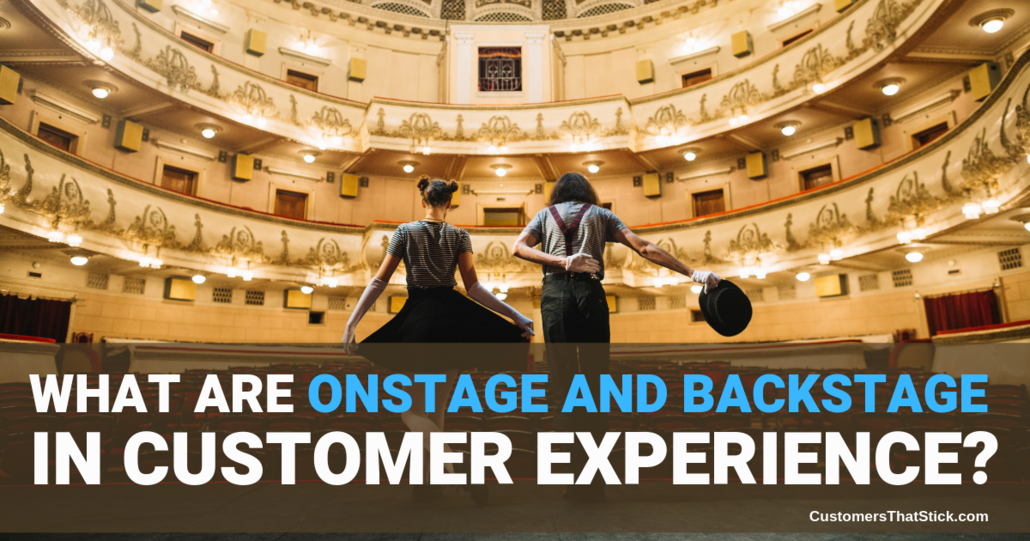
One of the questions I get a lot especially from people in trainings that are new to customer experience and customer service is, “What do onstage and backstage mean in customer experience?” Different roles in the organization can create different customer service expectations, so let’s take a look at these popular customer experience terms to better understand how they are used.
First of all, we have to give credit where it’s due. The Disney company really came up with this idea of being onstage in a customer-facing role.
One of the ways the Disney Corporation creates its legendary customer experiences is by viewing each experience as a show. Disney refers to its employees as cast members and refers to being customer-facing as being onstage.
In his book Be Our Guest, Theodore Kinni explains the onstage concept:
The Disney theme parks and their many cast members make a clear distinction between being onstage and offstage. In Disney-speak, cast members are onstage whenever they are in the public areas of the park and in front of guests. They are offstage when they are behind the scenes and out of their guests’ sight.
Theodore Kinni, Be Our Guest: Perfecting the Art of Customer Service (Disney Editions, 2003), Kindle ed., ch. 1, sec.: “Defining Practical Magic,” loc. 208.
Onstage means you are in front of a customer. The customer can see you, hear you, or otherwise take in what you are doing. You are a part of their experience at that moment.
Backstage means you’re not in front of the customer. They can’t see you, hear you, and so on, but you’re still part of their customer experience.
Please note that, despite the terminology in the quote above, people say both backstage and offstage in customer service to denote not being onstage.
Over the years, I’ve come to prefer backstage, because I believe it sends a signal that you’re still part of the production and can still have a vital role in the experience.
Understanding the difference between onstage and backstage is crucial to effective #CX.
What’s an example of a backstage role? How about line cooks?
The cooks prepare the food for customers and, as such, are integral to the customer experience, but the customers never see them.
So, why is it important to differentiate between onstage and backstage?
When we do customer blueprinting (simply put, a process which looks at both the customer journey and the ingredients behind the organizational execution for that journey), we look at both onstage and backstage views, because often the approach to both will be different.
As mentioned in Be Your Customer’s Hero:
The idea of being onstage is important because it sets the expectation that when you’re in front of customers in any form you have your game face on. It’s not about being inauthentic or not being yourself, but about acting in a manner conducive to your setting and to creating great customer experiences.
You want to know who is in front of a customer and who is not when establishing the service standards and the processes that person will follow.
Understanding the difference between onstage and backstage in customer experience is not only important for frontline teams but for leaders who want to help develop service standards and design Hero-Class® customer experiences.
Comments are closed.
© 2011-2025 CTS Service Solutions, LLC.
All rights reserved.
Legal Information | Privacy Policy
How to Cite this Site
I think many customer service professionals take “backstage” to mean they can stop being customer-friendly. I recently heard a retail associate loudly dropping f-bombs as she complained about someone else. Yes, she was technically “backstage” because she was in the stockroom, but she was so loud I could hear her on the retail sales floor!
For sure Jeff! We don’t want “backstage” to mean unprofessional. Leaders need to make sure that message is clear. That’s why I like “backstage” better than “offstage” — it hopefully sends a signal that they’re still part of the “production.”
What a great article! Many employees don’t realize that they are integral to the customer experience even if they don’t interact with the customer directly. Even if they aren’t seen or heard, their contribution is still experienced by the customer. The line cook is a great example!
Thank you so much Jessica! A common question I get is how do we connect [FILL IN BACKSTAGE ROLE HERE] to the customer experience? As you point out, it’s incredibly important for team members to understand their contribution.